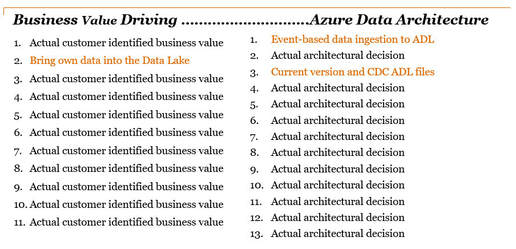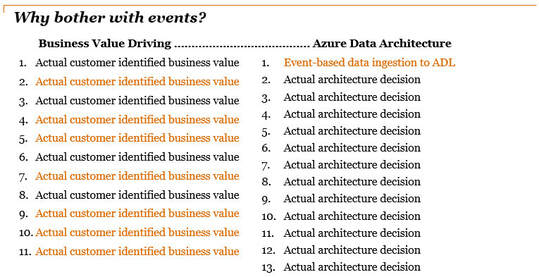
I have been on a long term Azure for BI implementation and took some time today for a "what went right", "what went wrong" and "what I'll do differently" introspection. Giving the outcome a bit of a positive twist, I'll try not to repeat what I've already shared in Data Architecture for BI Programs and Transitioning from Traditional to Azure Data Architectures. I actually thought I'd write about parameterized shared ADF datasets, or using Python to auto generate transform views and load store procedures. Instead, it appears that my fingers have reverted back to tool agnostic critical success points. (At least I know what I want to write about next!) My tool agnostic thoughts:
Go Get Your First Customer!
Here is a movie quote for you: "Build it and they will come". This thought process should be sent straight to Hades. Data architecture and analytics is not a Field of Dreams. Among other things, having an actual customer will result in a finished product that at least somebody wants. The best advertisement is word of mouth, and it is easier to sell a product that has at least one happy customer. It amazes me to see how many companies make this mistake. If you do not have one already, go get your first customer and put them on your design team. Now, how easy was that?!
Associate Each Data Architectural Decision with a Business Value
In my most recent project, my colleague, Joshuha Owen, and I put together a slide deck affiliating business value with data architectural decisions. There were several slides that looked similar to this for business users-->
Go Get Your First Customer!
Here is a movie quote for you: "Build it and they will come". This thought process should be sent straight to Hades. Data architecture and analytics is not a Field of Dreams. Among other things, having an actual customer will result in a finished product that at least somebody wants. The best advertisement is word of mouth, and it is easier to sell a product that has at least one happy customer. It amazes me to see how many companies make this mistake. If you do not have one already, go get your first customer and put them on your design team. Now, how easy was that?!
Associate Each Data Architectural Decision with a Business Value
In my most recent project, my colleague, Joshuha Owen, and I put together a slide deck affiliating business value with data architectural decisions. There were several slides that looked similar to this for business users-->

When trying to explain event-driven data ingestion to the technical team, I turned it around to look something like this -->

The point is: bring business value or bust. You can have all the data in the world sitting in your data lake or warehouse, but if your non-technical users can't do something with it, there is no business value. With no business value, your budget gets cut.
Deliver Incremental Business Value
Here is a popular thought: "Agile project management". When I worked for <some company that shall not be named who is NOT a recent engagement> they professed to be agile, but spelled it with a lower case "a". This meant that they had created their own manifesto. My recollection is a whole lot of waterfall in a lower case "a" implementation. I have observed that a team can have scrums, sprint planning, epics, features, user story points and tasks but if there are bringing several subject areas coming across the finish line at the same time, I feel that the ROI for delivering incremental business value earlier in the timeline has been lost.
Here is a very simple example. This is not agile, Agile, or anyone's good idea -->
Deliver Incremental Business Value
Here is a popular thought: "Agile project management". When I worked for <some company that shall not be named who is NOT a recent engagement> they professed to be agile, but spelled it with a lower case "a". This meant that they had created their own manifesto. My recollection is a whole lot of waterfall in a lower case "a" implementation. I have observed that a team can have scrums, sprint planning, epics, features, user story points and tasks but if there are bringing several subject areas coming across the finish line at the same time, I feel that the ROI for delivering incremental business value earlier in the timeline has been lost.
Here is a very simple example. This is not agile, Agile, or anyone's good idea -->

However, let's be fair. You will end up in a similar situation as pictured above when you have extenuating circumstances, like waiting for approvals, or your application vendor pushes an update to the Cloud which causes you to rework previously completed work. Projects have roadblocks that skew our perfectly planned timelines. What I am trying to communicate is that the above picture should not be your planned strategy for business value delivery.
In contrast, this is a very simplified picture of agile, Agile, or someone's great idea -->
In contrast, this is a very simplified picture of agile, Agile, or someone's great idea -->

Hold Something Back.
This is my new project management strategy learned from my recent engagement. I'm not a licensed PM, but I have come to love this idea. How many times have we wanted to "exceed expectations" so we deliver more than what was promised? Problem is, we are back in stress mode for the next delivery date. How about exceeding expectations, but delivering that extra bit mid-timeline? In other words, think about "keeping something completed in your back pocket". This is hard for me...I want to hit the ball out of the park every time, but how boring is that? Imagine if every batter hit the ball out of the park -- hot dogs and peanuts would be the best part of the game. You know what's fun? BASES LOADED! So ... let's load the timeline.

I have found myself in the above scenario when subject areas overlap in planning effort and therefore require less design or development because we have established a repeatable process.
If you have worked with me 1:1, how many times have I said, "we can, but we won't"? Wait 1, 2 & 3 are examples of holding something back -- you could go to production, but you don't /or/ you are in production but no one knows. (I prefer the latter.)
Summary of the Matter
Once again, my patient reader, thanks for reading! I value your time, and I feel honored if you are actually reading this last sentence. I love Azure for BI because it can be really fun (!!). Please post your own personal experiences, and let's help each other be successful.
If you have worked with me 1:1, how many times have I said, "we can, but we won't"? Wait 1, 2 & 3 are examples of holding something back -- you could go to production, but you don't /or/ you are in production but no one knows. (I prefer the latter.)
Summary of the Matter
Once again, my patient reader, thanks for reading! I value your time, and I feel honored if you are actually reading this last sentence. I love Azure for BI because it can be really fun (!!). Please post your own personal experiences, and let's help each other be successful.
Sign-up now and get instant access

Free Community Plan
On-demand learning
Most Recent
private training



.jpg?width=406&name=Eans%20YouTube%20Thumbnails%20(2).jpg)


-1.png)
Leave a comment